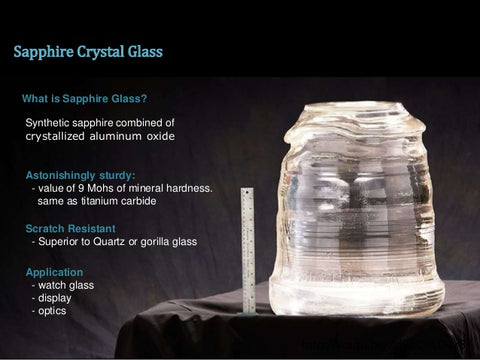Sapphire vs. Mineral
Is a sapphire crystal worth the extra cost?

Which is the right crystal for my watch?
As the window to your timepiece, the watch crystal (or “glass”) takes some of the hardest hits and is the brunt of everyday wear and tear. There are 3 main types of watch crystal:
- Plastic / Acrylic: These used to be the norm. The plastic material is relatively soft, so as you would expect, is the least expensive. Because it is quite soft and flexible, it is also the least likely to shatter and the most likely to become scratched. One advantage is that, if it does get scratched and you have a polishing machine, then smaller scratches can often be buffed or polished away.
- Mineral Glass: These are common on most mid-range watches. They are a little more expensive than plastic or acrylic crystals but are significantly more scratch resistant. They are made of glass. Almost all Mineral Glass Watch Crystals nowadays are “Tempered” Mineral Glass. This just means that the surface of the glass is “heat-tempered” (heated to a high temperature), giving the surface of the glass increased scratch resistance and making it less likely to “splinter”. If a mineral crystal is scratched or chipped, then it cannot be polished and “repaired”, it needs to be replaced.

- Synthetic Sapphire: A synthetic sapphire crystal or “glass” is actually not glass at all. It is a very hard, transparent material made of crystallizing pure aluminium oxide at very high temperatures. Synthetic sapphire has the same hardness as natural sapphire gemstones, but without the coloring agents that give the gems their various hues. When it is heated, the synthetic sapphire forms round masses, that are then sliced into pieces with diamond-coated saws. These disks are then ground and polished into watch crystals. (One reason sapphire crystals are relatively expensive is that the tools required to cut and polish this extremely hard material are very costly.) Sapphire (whether natural or synthetic) is one of the hardest substances on earth. It measures 9 on the Mohs scale, which is a system for rating the relative hardness of various materials. (Diamond measures 10, the highest rating.) Watch crystals made of synthetic sapphire are often marketed as “scratch resistant” or “virtually scratchproof” because they are very difficult - but not impossible - to scratch. Diamond can scratch them; so can man-made materials that incorporate silicon carbide, which, with a MOHS rating of between 9 and 10, is harder than sapphire. So, if you accidentally scratch your watch on a simulated-stone surface or a wall that incorporates some of these silicon carbide materials, it could scratch the crystal.
We are BIG advocates of sapphire crystals!
AR Coatings:
Sapphire crystal is more reflective than mineral crystal due to its higher index of refraction. (1,8 compared to 1,47). Applying one or more layers of AR (anti-reflective) coating will limit this reflection to a very low level. Very often, lines and marks on the top surface of a sapphire crystal are mistaken for scratches but are actually the scratched AR coating, or just AR coating wearing off after time. An AR coating on the inside of the crystal provides a good AR performance while avoiding this problem. If you do scratch a sapphire crystal, then it cannot be polished away and will need to be replaced.

Waterproof gasket:
As both mineral and sapphire crystals are extremely hard, they have little or no “flex”. This means that when the crystal is inserted into a hard, steel or titanium watch case, it requires a gasket to ensure a waterproof seal. These crystal gaskets are typically made of nylon, and are either flat, “I”-shaped or “L”-shaped. (see example above). The crystal is pressed into the case, using a crystal press tool. When it is pressed in, the nylon crystal gasket is “squeezed” between the crystal and the case rim, making a reliable waterproof seal. Over time, these crystal gaskets can become brittle and break, so it is a good idea change the crystal gaskets every few years, to ensure the ongoing waterproof performance of your watch.
Mineral or Sapphire? Hard to decide?
If you are really tough on your watch and need it to take a “beating”, then sapphire is clearly the way to go. If you are not that tough on your watch and are unsure whether you really need sapphire, then you can always order your watch with a regular mineral crystal. If you find it gets scratched up over the first year or two, then you can just ask our Service Department to upgrade your watch to a sapphire crystal, next time you send it in for service!
































































